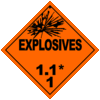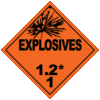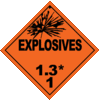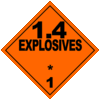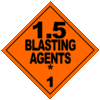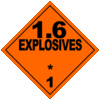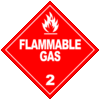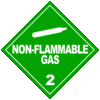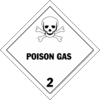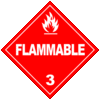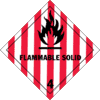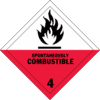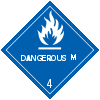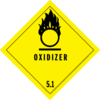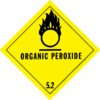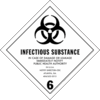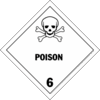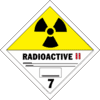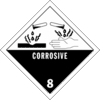The International Maritime Dangerous Goods (IMDG) Codes
The International Maritime Dangerous Goods (IMDG) Code was developed as a uniform international code for the transport of dangerous goods by sea covering such matters as packing, container traffic
The Carriage of dangerous goods and marine pollutants in sea-going ships is respectively regulated in the International Convention for the Safety of the Life at Sea (SOLAS) and the International Convention for the Prevention of
Relevant parts of both SOLAS and MARPOL have been worked out in great detail and are included in the International Maritime Dangerous Goods (IMDG) Code, thus making this Code the legal instrument for maritime transport of dangerous goods and marine pollutants. As of 1st January 2004, the IMDG Code will become a mandatory requirement.
For all modes of transport (sea, air, rail, road and inland waterways) the classification (grouping) of dangerous goods, by type of risk involved, has been drawn up by the UNITED NATIONS Committee of Experts on the Transport of Dangerous Goods (UN).
Class 1
|
Subclass 1.1: Explosives with a mass explosion hazard Consists of explosives that have a mass explosion hazard. A mass explosion is one which affects almost the entire load instantaneously. |
|
Subclass 1.2: Explosives with a severe projection hazard Consists of explosives that have a projection hazard but not a mass explosion hazard. |
|
Subclass 1.3: Explosives with a fire Consists of explosives that have a fire hazard and either a minor blast hazard or a minor projection hazard or both but not a mass explosion hazard. |
|
Subclass 1.4: Minor fire or projection hazard Consists of explosives that present a minor explosion hazard. The explosive effects are largely confined to the package and no projection of fragments of appreciable size or range is to be expected. An external fire must not cause virtually instantaneous explosion of almost the entire contents of the package. |
|
Subclass 1.5: An insensitive substance
with a mass explosion hazard Consists of very insensitive explosives with a mass explosion hazard (explosion similar to 1.1). This division is comprised of substances which have a mass explosion hazard but are so insensitive that there is very little probability of initiation or of transition from burning to detonation under normal conditions of transport. |
|
Subclass 1.6: Extremely insensitive articles Consists of extremely insensitive articles which do not have a mass explosive hazard. This division is comprised of articles which contain only extremely insensitive detonating substances and which demonstrate a negligible probability of accidental initiation or propagation. |
Class
|
Subclass 2.1: Flammable Gas Gases which ignite on contact with an ignition source, such as acetylene and hydrogen. Flammable gas gas means any material which is ignitable at 101.3 kPa (14.7 psi) when in a mixture of 13 percent or less by volume with air, or has a flammable range at 101.3 kPa (14.7 psi) with air of at least 12 percent regardless of the lower limit. |
|
Subclass 2.2: Non-Flammable Gases Gases which are neither flammable nor poisonous. Includes the cryogenic gases/liquids (temperatures of below -100°C) used for cryopreservation and rocket fuels. This division includes compressed gas, liquefied gas, pressurized cryogenic gas, compressed gas in solution, asphyxiant gas and oxidizing gas. A non-flammable, nonpoisonous compressed gas means any material which exerts in the packaging an absolute pressure of 280 kPa (40.6 psia) or greater at 20°C (68°F), and does not meet the definition of Division 2.1 or 2.3. |
|
Subclass 2.3: Poisonous Gases Gases liable to cause death or serious injury to human health if inhaled. Gas poisonous by inhalation means a material which is a gas at 20°C or less and a pressure of 101.3 kPa (a material which has a boiling point of 20°C or less at 101.3kPa (14.7 psi)) which is known to be so toxic to humans as to pose a hazard to health during transportation, or in the absence f adequate data on human toxicity, is presumed to be toxic to humans because when tested on laboratory animals it has an LC50 value of not more than 5000 ml/m3. |
Class 3:Flammable Liquids
A flammable liquid means a liquid which may catch fire easily or any mixture having one or more components whith any flash point. As example: acetone, diesel, gasoline, kerosene, oil etc. There is strongly recomended for transportation at or above its flash point in a bulk packaging. There are three main groups of flammable liquid.Low flash point – liquids with flash point below -18°CIntermediate flash point – liquids with flash point from -18°C. up to +23°CHigh flash point group – liquids with flash point from +23°C
Class 4:Flammable solids or substances
|
Subclass 4.1: Flammable solids Solid substances that are easily ignited. Self-reactive materials, which are thermally unstable and that can undergo a strongly exothermic decomposition even without participation of air. Readily combustible solids that can cause a fire through friction and show a burning rate faster than 2.2 mm (0.087 inches) per second, or metal powders that can be ignited and react over the whole length of a sample in 10 minutes or less. |
|
Subclass 4.2: Spontaneously combustible solids Solid substances that ignite spontaneously. Spontaneously combustible material is a pyrophoric material, which is a liquid or solid that can ignite within five minutes after coming in contact with air or a self-heating material that when in contact with air and without an energy supply is liable to self-heat. |
|
Subclass 4.3: Dangerous when wet Solid substances that emit a flammable gas when wet. Dangerous when wet material is a material that when it makes contact with water is liable to become spontaneously flammable or give off flammable or toxic gas at a rate greater than 1 L per kilogram of the material per hour. |
Class 5: Oxidizing substances and organic peroxides
|
Subclass
5.1: Oxidizing
agent Oxidizing agent means a material that may, generally by yielding oxygen, cause or enhance the combustion of other materials. | |
|
Subclass 5.2: Organic peroxide oxidizing agent Organic peroxide means any organic compound containing oxygen in the bivalent structure and which may be considered a derivative of hydrogen peroxide, where one or more of the hydrogen atoms have been replaced by organic radicals. |
Class 6:Toxic and infectious substances
|
Subclass
6.1: Poison Toxic substances which are able to cause death or serious hazard to humans health during transportation. |
|
Subclass
6.2: Biohazard Infectious Substance material is known to contain or suspected of containing a pathogen. Infectious substances are substances which are known or are reasonably expected to contain pathogens. Pathogens are defined as micro-organisms (including bacteria, viruses, rickettsiae, parasites, fungi) and other agents such as prions, which can cause disease in humans or animals. |
Class 7: Radioactive substances
Radioactive
Radioactive substances comprise substances or a combination of substances which
emit ionizing radiation
Class 8:Corrosive substances
Corrosive
Corrosive materials means a liquid or solid that causes full thickness destruction
of human skin at the site of contact within a specified period of time. A
liquid that has a severe corrosion rate on steel or aluminum is also a
corrosive material.
Class 9:Miscellaneous dangerous substances and articles

|
Miscellaneous A material which presents a hazard during transportation but which does not meet the definition of any other hazard class. This class includes: any material which has an anesthetic, noxious or other similar property which could cause extreme annoyance or discomfort to a flight crew member so as to prevent the correct performance of assigned duties or material for an elevated temperature material, a hazardous substance, a hazardous waste, or a marine pollutant. |
